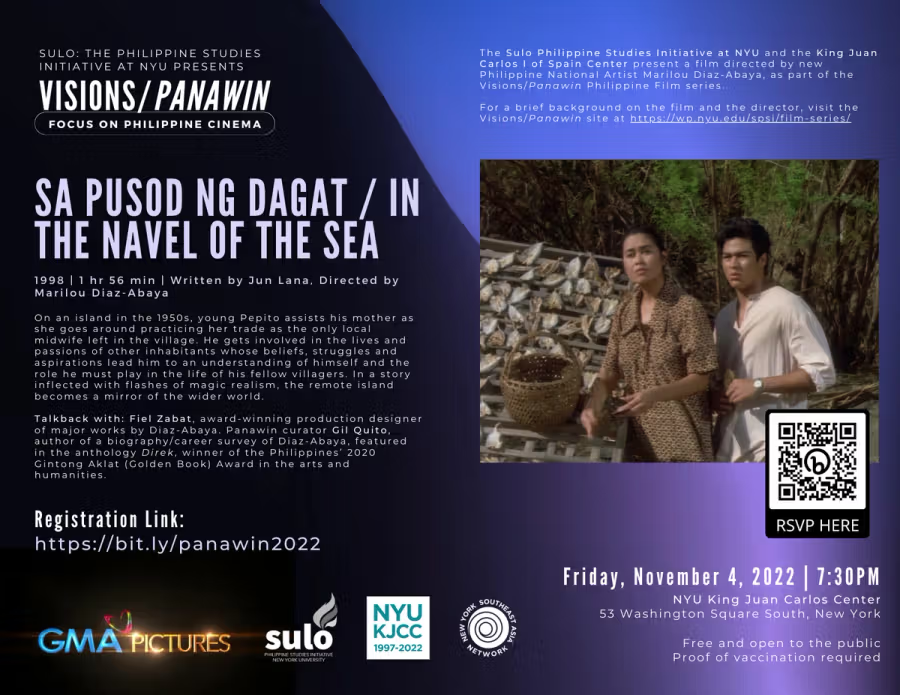News
VISIONS/PANAWIN FILM SERIES | FOCUS ON PHILIPPINE CINEMA: "In the Navel of the Sea (Sa Pusod ng Dagat)"


Friday, November 4, 2022, 7:30 pm KJCC, 53 Washington Square S, NY 10012 RSVP: https://tinyurl.com/yvtrhs2w More info here: https://tinyurl.com/2p9xx8yz
In the Navel of the Sea (Sa Pusod ng Dagat)
1998 | 1hr 56m | Written by Jun Lana, Directed by Marilou Diaz-Abaya
Synopsis
On an island in the 1950s, young Pepito assists his mother as she goes around practicing her trade as the only local midwife left in the village. He gets involved in the lives and passions of other inhabitants whose beliefs, struggles and aspirations lead him to an understanding of himself and the role he must play in the life of his fellow villagers. In a story inflected with flashes of magic realism, the remote island becomes a mirror of the wider world.
Notes on the Film and Director
Visitors to the Philippines who are keen to observe its lively film scene are struck by the prominence and preponderance of women film directors, especially in its mainstream cinema. This was not the case when Abaya began her career in 1980, after finishing a Communication Arts degree at Assumption College in Manila and filmmaking courses at the Loyola Marymount University in Los Angeles and the London International Film School. At that time, one could count with the fingers of one hand the number of female directors in the industry. Her resonating renown as one of the Philippines’ premier directors, irrespective of gender, paved the way for the rise of women filmmakers in the industry and has inspired indie filmmakers of all gender leanings to follow suit. Her influence on Philippine art and culture was recognized last June with the posthumous conferment of National Artist, the country’s highest honor in the arts.
Abaya jumped to the vanguard of Philippine filmmakers at the start of her career with a trilogy of highly acclaimed feminist films (Brutal, Moral, and Karnal) that she created with screenplay-writer Ricky Lee. In the Navel of the Sea came at a turning point in her career when she was expanding to works focusing on wider social and metaphysical themes. This film foreshadows the epic films that she would soon direct, notably the biographical Jose Rizal, at that time the most expensive Philippine film ever made. In the Navel evinces the compassion for marginalized communities and characters that infused many of Abaya’s films. Beyond her activities as director and mentor in a film school she established, she was an active member of the Concerned Artists of the Philippines founded by Lino Brocka to rally against the Martial Law dictatorship and its overbearing media censorship.
Abaya, an avid scuba diver, shot most of In the Navel in the fishing hamlets in Batangas, and her love for nature and the sea suffuses the film, glowingly photographed by Romeo Vitug. In the Navel captures the backwardness of the island community but also its wonderment, and consequently, the story has an air of both gritty realism and myth. (Abaya was a fan of Gabriel Garcia Marquez and his magic realist novels.) In its depiction of the cycle of births, passions, deaths, and redemption, the film turns sensual lives in an insular community into a microcosm of humanity grappling with all too familiar yet all too mysterious metaphysical dilemmas.
— Gil Quito Panawin Curator